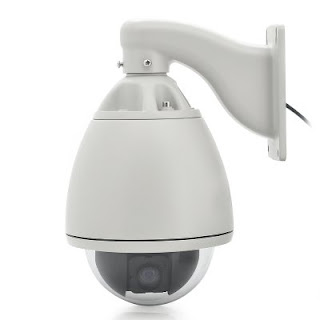Factors to Consider When Purchasing a PTZ IP Camera
PTZ IP cameras are
commonly used for surveillance in large home compounds and public areas such as
commercial car parks, stadiums and conference halls. PTZ stands for Pan Tilt
Zoom, and that means you can use the IP software for cameras through the
internet or your network to manipulate what the IP camera displays.
Different IP camera brands sport different kinds of zooms, and
lower end cameras will simply feature the digital zoom. Proper optical zoom is
the recommendable zoom type and this, together with the price, will always be
specified in the product description.
Basically, a PTZ IP
camera lets the user view real time images of the protected areas over the
internet. You can simply monitor your office, home, building, yard or anywhere
from miles away using a PC or a high end smartphone, tablet or PDA. Some
network cameras even feature built-in Web server functions such that the IP
camera doesn’t necessarily need to be connected to a computer.
DESIGN
IP PTZ cameras are
traditionally spherical in shape, and this is mainly because they are meant to
be completely mobile. Either the network camera itself (the sensor and camera
mechanism) has been designed to take the shape of a sphere, and held so that it
can pivot accordingly, or the camera is structured more traditionally and cased
in a spherical protective bubble where it can tilt, pan and zoom and take
images from within the shield.
NIGHT VISION
IP cameras with night vision capabilities come with
built-in LED lighting to enable object visibility in dark settings, or at
night. For outdoor surveillance, specifically in places without artificial
lighting, night vision cameras may come in handy.
PTZ vs PT
Some IP cameras can only pan and tilt but not zoom. The
two functions will usually be enough if the area you want to cover is small,
like, say, your living room. However, if you want to cover a large area such as
a shopping mall, an IP camera with the zoom function will be more effective.
HOW DO THEY WORK ?
PTZ IP cameras are typically controlled using remote
systems. Users can do an initial configuration to have the camera moving and
rotating in a certain predetermined pattern, or do it manually using a keyboard
or mouse controlled interface. The angle of the lens can also be manually
controlled, and this facilitates automatic position adjustment of the camera.
BENEFITS OF PTZ IP CAMERAS
·
User does not need to
be close to the camera to operate it.
·
Requires little
maintenance after it has been installed (except for regular cleaning of
course).
·
Has 360-degree
mobility. This way, it can detect and track objects as they move in the covered
area as long as the target object is within lens range.
Factors to Consider When Purchasing a PTZ IP Camera
INDOOR OR OUTDOOR USE ?
If you’re looking for a PTZ IP camera for outdoor
surveillance, you need one with night vision, weatherproof enclosure, miniature
architecture for “outsider” visibility reasons, and vandal-proof capability for
fortification in high crime areas.
YOUR DESIRED CAMERA FORM FACTOR
Each form factor has its own benefits, and the brand you
opt for should cover all your surveillance requirements. Would you prefer a
dome-shaped or an inconspicuous mini-dome camera? A wireless option or just an
ordinary corded PTZ IP camera? You know your place and specifications best.
When weighing different camera alternatives, you need to
be sure of the detail level you want to see in your images. For wide area
surveillance, you need a higher resolution, of course, as this will allow you
to view even the furthest of images in relatively great detail.
Another factor that affects a camera’s resolution is its
field of view (FOV). This is the viewable expanse of a given scene taken by the
camera, and is sometimes referred as the angle of coverage or angle of view. A
small FOV generally leads to the target object appearing smaller than it would
in a fairly larger FOV.
The type of lens featured in the camera will also have an
impact on resolution and field of view alike. A lens with low focal length
number will bring about a wide field of view but less magnification while a
higher focal length number will provide more magnification.
PTZ IP cameras, just like ordinary cameras, come with
different resolution capabilities, and if you choose a high-resolution one, you
also need to choose a high resolution megapixel lens so that the resolution
required to produce a clear and detailed image can be maintained. If you
combine a high resolution camera sensor with a less powerful lens, then your
images will not be as detailed and crisp as you may desire.
POWER
Each PTZ camera is shipped with its own power supply. Some cameras operate on 12v DC and some on 24v AC. Make sure you note the type of power the camera uses and that the power supply matches the camera.
POWER
PTZ cameras have multiple motors built-in which draw a
considerable amount of power compared to a regular surveillance camera. Power
can be supplied locally at the camera location or a cable can be pulled from a
power source to the camera. The size of the wire dictates the maximum distance
the cable can extend from the camera to the power source. See the chart below.
·
12 Gauge Wire – Maximum Distance 320 Feet
·
14 Gauge Wire – Maximum Distance 225 Feet
·
16 Gauge Wire – Maximum Distance 150 Feet
·
18 Gauge Wire – Maximum Distance 100 Feet
Each PTZ camera is shipped with its own power supply. Some cameras operate on 12v DC and some on 24v AC. Make sure you note the type of power the camera uses and that the power supply matches the camera.








